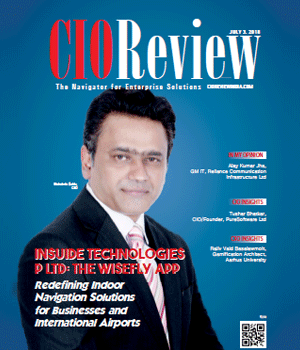
Innovation, In Any Enterprise A Myth Or Reality?
Mahantesh Patil, Head - DevOps, Larsen &Toubro Infotech Ltd | Thursday, 26 July 2018, 06:58 IST
 When you look at the business scenarios around us and the way disruptive technologies have shaped our lifestyles and emergence of new businesses or services you see the need to have “creativity” as a DNA built into the culture of an Enterprise. But, a greater question is “How to do it” or “Is it possible to make it happen?”… When you hear this word “creativity”, your mind thinks of artistic works of sculptors, musicians and entertainment artists, mostly. Is it possible to have the same thinking for CEOs, Engineers, Management Professionals? But, if we believe we’re all creative and think it possible to have ideas generated in daily professional work, then the core of innovation can be explored to democratize across.
When you look at the business scenarios around us and the way disruptive technologies have shaped our lifestyles and emergence of new businesses or services you see the need to have “creativity” as a DNA built into the culture of an Enterprise. But, a greater question is “How to do it” or “Is it possible to make it happen?”… When you hear this word “creativity”, your mind thinks of artistic works of sculptors, musicians and entertainment artists, mostly. Is it possible to have the same thinking for CEOs, Engineers, Management Professionals? But, if we believe we’re all creative and think it possible to have ideas generated in daily professional work, then the core of innovation can be explored to democratize across.
Innovation happens through different stages and in some cases, may not be sequential. Typical approach to Innovation can be:
• Discover
• Synthesis/Insight
• Ideation and Experimentation
• Execution
Discover: Instead of waiting for the Eureka moment to happen, we go out to seek the experiences that will spark creative thinking. Interact with the experts, immerse in the problem space in unfamiliar environments. This is fueled by an intentional plan of actions driven by the curiosity.
To inspire human-centered innovation, empathy is our reliable, go-to resource. It is a necessity to connect with the needs, desires, and motivations of real people help to inspire and provoke new ideas.
Synthesis: The immersion in Empathy, will lead to next challenging step of “Sense Making”. This needs to focus on patterns, insights, connections, themes, mapped as “affinity”. Striving is to see where is the unstated need or the opportunity ground to define and redefine the problem to understand the right need. The culmination of this phase will be to ask “How Might We…” and get to macro-level perspective of what can be defined as a “right” problem.
"Although, innovations are based on new knowledge are often powerful, there is generally a long time span between development of new knowledge and its transformation into commercially viable products"
Ideation and Experimentation: Next step would be to explore the new possibilities and generate as many ideas as possible not focusing on “how” part of the execution. This takes multiple iterations of thinking, prototyping, and understanding “what will not work” - quickly. Experimenting will focus on feedback from Users and simulate the form or functions to get to the future state of need.
Execution: Before committing to an idea with them and money, better would be to refine the design and prepare a roadmap to execute the scale that makes a better sense. Implementation may have many phases or rounds. 3M had painstaking and skeptical two years of experimentation on mask tape just to master the lighter adhesiveness and thickness of the tape to get “zero” paint damage when used.
Design thinking is a way of finding human needs design and creating new solutions using tools and mindsets of design practitioners. This framework largely uses the steps narrated above. Next question is – is it possible to manage the creativity and innovation? Answer can be provided in the following sections:
• New Knowledge as a source of Innovation
• Learning from Lead Users
• Empathetic Design
• Generating Ideas through Labs
• Role of Mental Preparation
• How Management can encourage Idea Generation
New Knowledge: Many, if not most, radical innovations are the product of new knowledge. Consider the evolution of Computer. It has many news sources of chips, ways of processing, media management and threads to deal with. Processing speed and power consumption have driven the sources of knowledge to continuously challenge and release something new.
Although, innovations are based on new knowledge are often powerful, there is generally a long time span between development of new knowledge and its transformation into commercially viable products. Customers are evergreen source of innovative ideas for any professional in functions. Defining a Customer is important whether it is internal or external to the enterprise. The ecosystem if an Enterprise needs to drive the culture of using new sources of knowledge in all the endeavors where it finds a better sense.
Learning from Lead Users: Lead Users are another source of innovative ideas. Lead Users are companies and individuals – customers and noncustomers – whose needs are far ahead of market trends. Look for the trends, learn from Lead Users and develop ideas. Lead User like use the same for all smart phones without physical keys on phone.
Empathetic Design: One of the problems that innovators face in determining market needs is that target customers can’t always recognize or articulate their future needs. Empathetic Design is a technique for doing whereby innovators observe how people use existing products and services in their own environments.
Harley-Davidson uses this technique to send engineers, marketing personnel, and even social anthropologist to Harley Owners Groups (HOG) events. These employees observe how Harley owners use and customize their bikes, the problems they encounter, and so forth. These observations become the raw materials for innovative ideas.
Generating Ideas through Labs: Many large manufacturers generate and develop innovative ideas through formal research and development units - innovation factories or labs. This infrastructure provides an opportunity to explore without any constraints and work on the passion than KPI driven operational objectives. In fact, 3M has created KPIs which include this as part of employee goals to work in innovation labs or help with any innovations, 30% of their time. This leads to the creation of the DNA of innovations more trickled down to all functions, if not quickly over a period.
Role of Mental Preparation: Although it is true that many ideas are generated unintentionally through random observations, routine contacts with customers and even unintended laboratory results, it is true - to quote Louis Pasteur - that “Chance favors the prepared mind”. A prepared mind is more likely to formulate a problem-solving idea or recognize an opportunity.
Preparation is often cited as the first step in the creative process that leads to innovation. To prepare themselves for idea generation, would be innovators should immerse themselves in problem space, more. As suggested by one expert on managing creativity, they should do the following:
• earch the literature
• Look at all sides of the problem
• Talk with people who are p familiar with the problem
• Play with the problem
• Ignore the accepted wisdom
How Management can encourage Idea Generation: If innovation is a key function of companies, then management has a responsibility to encourage the generation of innovative ideas. Both traditional and non-traditional tools can be used for this task. These tools include:
• rewards,
• a climate of innovation,
• hiring innovative mindsets,
• encouraging the cross-pollination of ideas and
• providing support for innovations
CIO Viewpoint
UX- The broad picture from 'what was' to 'what...
By Kamal Sharma, CIO, Tally Solutions Pvt. Ltd.
IoT - Initiating the Next Industrial Revolution
By Vipin Kumar, Group CIO, Escorts
Creating a Tangible Impact through Collaboration
By Matt Schlabig, CIO, Worthington Industries
CXO Insights
When the Internet of Things meets Analytics
By Salil Godika, Chief Strategy & Marketing Officer, Happiest Minds Technologies
Cyber Risks: Balancing Innovation and Resilience
By Aditya Samag, VP-Cyber Risk, Marsh India Insurance Brokers
Perfect Plant Initiative Embraced with Industry...







